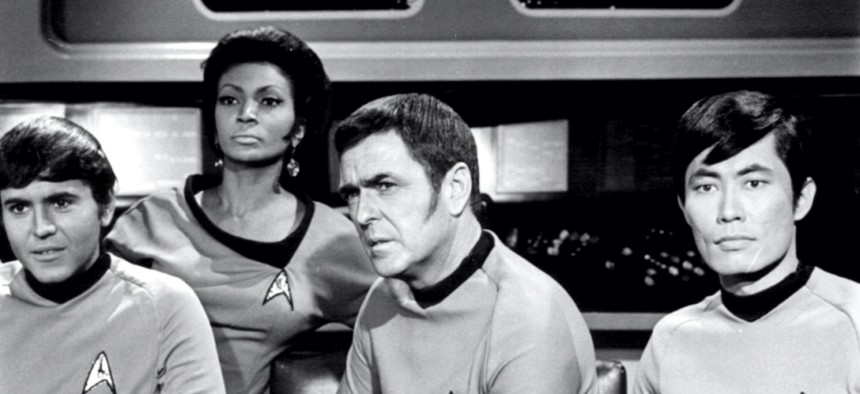
Publicity photo of crew members of the USS Enterprise (NCC 1701) NBC Television
Space Force Should Embrace the Natural Inclusivity of Space Nerds
It would make the nascent service better at many things, including recruiting.
The first black-white kiss on U.S. television occurred between Lt. Uhura and Captain Kirk, a controversial-for-1968 decision that reflected Star Trek creator Gene Roddenberry’s broader philosophical commitment to addressing race in his science fiction. This bold approach to diversity and inclusion is a fundamental element of the self-selecting group of space nerds that comprise the Space Force. As the newest service branch finds its feet, it should embrace this ethos — a proven aid to recruitment, readiness, and mission success — as fundamental to its identity.
Much of science fiction, from Jules Verne to Nnedi Okorafor, is predicated on a broad definition of diversity and inclusion. To be a space nerd, you have to extend diversity and inclusion considerations beyond intrinsic human demographic metrics – otherness is not just about race, age, sex, religion, and sexual orientation. Otherness in outer space is about different life forms, fundamental communication abilities, and competing values. I have been warned against proselytizing about science fiction when discussing Space Force matters because the general public may misunderstand the intent. But as a community of space nerds, we should acknowledge that our calling to space-related pursuits may also provide us a foundational advantage.
Space Force’s first commander, Gen. Jay Raymond, is saying the right things. “We must build diversity and inclusion into our ‘cultural DNA’ — make it one of the bedrock strengths of our service,” he wrote in June. But to be blunt, his year-old branch is at a dangerous and precarious inflection point. It is being bogged down by miscommunication missteps, accusations of partisanship, and the risk of empty rhetoric around diversity and inclusion. This is compounded by legitimate questions about the strategic implications of recognizing space as a warfighting domain, the operational imperative to integrate space into a joint-all domain operating concept, and the programmatic challenges of competing for defense resources. (Apparent jokes from a White House podium don’t help.) As the service struggles to adjust its public messaging, it should further emphasize its embrace of diversity and inclusion as a clear sign that it intends to harness the best brains to meet clear operational needs.
More than words are required, of course. Here are some additional actions the service should take:
Implement the DOD’s diversity and inclusion recommendations. On Dec. 18, DoD released recommendations to improve racial and ethnic diversity and inclusion in the military, the product of a 15-member board led by the Air Force secretary. Implementing these in Space Force is necessary, if hardly sufficient.
Value diversity and inclusion across different dimensions. Space operators, who are used to working within higher dimensional spaces when working through orbital mechanics, should also look beyond race, age, sex, gender, religion, and sexual orientation as metrics for achieving demographic equity. As it embraces representation, Space Force should also look at the intersectionality of the individuals it is trying to retain and promote. That includes valuing a diverse range of personal perspectives and professional experiences. It means raising up voices of dissent and dissatisfaction, experimenting with different approaches to acquisition challenges, and it means valuing the role of the individual in the achievement of operational success because of (and not in spite of) challenging life and family circumstances.
Embrace what makes space different. The Space Force was established to address systemic cultural and acquisition issues that a bipartisan and bicameral group of our elected officials believed was so broken it could not be fixed within the existing structure of the Department of the Air Force. While the Space Force continues to define its culture and its relative independence from the Air Force through modest changes to its rank structure, it should more fully embrace its differences in how it views itself, its mission, and its strategic objectives. Diversity and inclusion should not just be a baseline for the Space Force but should also be the unique characteristic that sets it apart from its sister services and the pointy tip of the spear that facilitates mission success and readiness.
What makes science fiction fans celebrate a broad definition of diversity and inclusion resonates deeply within the community of space nerds that find refuge in the U.S. Space Force in service of our nation. Space Force leaders should use that innate sense of inclusion to help the service achieve its mission objectives. If the Space Force fails in this endeavor, it may end up sidelined and misunderstood, sharing the unfortunate fate of the protagonist of the first modern science fiction novel.
Sarah Mineiro was the staff lead of the Strategic Forces Subcommittee on the House Armed Services Committee when the Space Force language was drafted, negotiated, and signed. She is now an adjunct senior fellow with the Center for New American Security.



